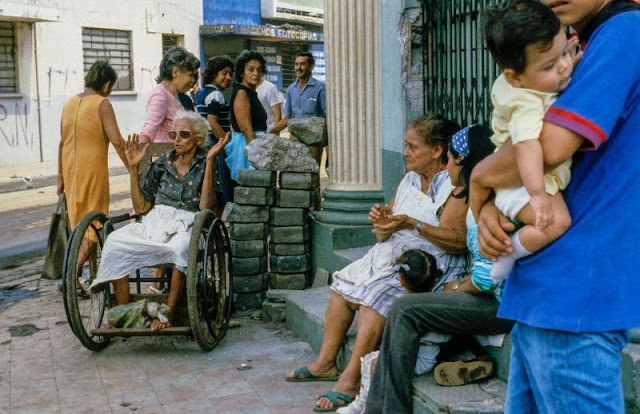Nicaragua is the largest country in the Central American isthmus, bordered by Honduras to the northwest, the Caribbean to the east, Costa Rica to the south, and the Pacific Ocean to the southwest. Managua is the country’s capital and largest city and is also the third-largest city in Central America, behind Tegucigalpa and Guatemala City.
 |
| Nicaragua in the 1970s |
The multi-ethnic population includes people of indigenous, European, African, and Asian heritage. The main language is Spanish. Indigenous tribes on the Mosquito Coast speak their own languages and English.
Since Nicaragua gained independence from Spain in 1821, the country has undergone periods of political unrest, dictatorship, occupation and fiscal crisis, including the Nicaraguan Revolution of the 1960s and 1970s and the Contra War of the 1980s.
The mixture of cultural traditions has generated substantial diversity in folklore, cuisine, music, and literature, particularly the latter. Known as the “land of lakes and volcanoes”, Nicaragua is also home to the Bosawás Biosphere Reserve, the second-largest rainforest of the Americas. The biological diversity, warm tropical climate and active volcanoes make Nicaragua an increasingly popular tourist destination.
Chilean photographer
Marcelo Montecino took these amazing photos that documented life of Nicaragua in the 1970s.
 |
| Child, Masaya, Nicaragua, circa 1970s |
 |
| Chinandega, Nicaragua, circa 1970s |
 |
| Somoza Forever, Leon, Nicaragua, 1974 |
 |
| Children of the sea, Nicaragua, 1975 |
 |
| Fishermen, Poneloya, Nicaragua, 1975 |
 |
| Masaya, Nicaragua, 1975 |
 |
| Masaya, Nicaragua, 1975 |
 |
| Poneloya, Nicaragua, 1975 |
 |
| The studio, Masaya, Nicaragua, 1975 |
 |
| The vendor, Masaya, Nicaragua, 1975 |
 |
| Common and political prisoners, Managua, Nicaragua, 1978 |
 |
| Estelí, Nicaragua, 1978 |
 |
| Family of disappeared, Managua, Nicaragua, 1978 |
 |
| Massacre site, Masaya, Nicaragua, 1978 |
 |
| Political prisoner, Managua, Nicaragua, 1978 |
 |
| Political prisoners, Estelí, Nicaragua, 1978 |
 |
| Political prisoners, Estelí, Nicaragua, 1978 |
 |
| Political prisoners, Leon, Nicaragua, 1978 |
 |
| Political prisoners, Managua, Nicaragua, 1978 |
 |
| Political prisoners, Managua, Nicaragua, 1978 |
 |
| The political prisoner, León, Nicaragua, 1978 |
 |
| This prisoner had battery acid poured on his shoulder by Somoza's National Guard, Managua, 1978 |
 |
| Wall reads: "for every fallen martyr, 10,000 are born", Managua, Nicaragua, 1978 |
 |
| After the battle, Rivas, Nicaragua, 1979 |
 |
| After the War, Masaya, Nicaragua, 1979 |
 |
| Angelito, Masaya, Nicaragua, 1979 |
 |
| Campesino, Nicaragua, 1979 |
 |
| Campesinos, near Chinandega, Nicaragua, 1979 |
 |
| Carnival in Masaya, Nicaragua, 1979 |
 |
| Chinandega, Nicaragua, 1979 |
 |
| Day of the triumph of the revolution, Managua, Nicaragua, 1979 |
 |
| Devotion in Masaya, Nicaragua, 1979 |
 |
| Dole banana plantation, Chinandega, Nicaragua, 1979 |
 |
| Estelí, Nicaragua, 1979 |
 |
| Executions by the lake, Managua, 1979 |
 |
| Festival in Masaya, Nicaragua, 1979 |
 |
| Folk festival, Masaya, Nicaragua, 1979 |
 |
| Funeral for a commander, Chinandega, Nicaragua, 1979 |
 |
| Hanging out, Managua, Nicaragua, 1979 |
 |
| Jubilation in Managua as Sandinistas entered the city, July, 1979 |
 |
| Last executions, Managua, 1979 |
 |
| Marimba, Managua, Nicaragua, 1979 |
 |
| Masaya, Nicaragua, 1979 |
 |
| Masaya, Nicaragua, 1979 |
 |
| Morning in Masaya, Nicaragua, circa 1979 |
 |
| Peasants political rally, Estelí, Nicaragua, 1979 |
 |
| Red set welcome for weary Sandis after weeks of fighting, July 20, 1979 |
 |
| Sandinistas welcomed in Managua, Nicaragua, July 1979 |
 |
| Shoeshine boys, Estelí, Nicaragua, 1979 |
 |
| Stencil reads: “Organize the masses to create the basic conditions of the war and make war foster the political-organizational of the masses”, Masaya, Nicaragua, 1979 |
 |
| Sugar mill workers, Kukra Hill, Nicaragua, circa 1979 |
 |
| The procession, Masaya, Nicaragua, 1979 |
(Photo © Marcelo Montecino)





























































And now they flood the US in order to vote FOR Marxism....ironic and sad.
ReplyDeleteActually the dictator and his family that were defeated were kept in power due to usa financing. Usa troops trained the army that oppressed the people. Know your history. One more dictatorship financed with USA tax payer dollars.
DeleteRemarkable photographs. What a change from the revolution of 1978-79 to the repression of the Ortega regime today. I have similar pictures of Nicaragua from 1963.
ReplyDelete